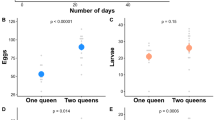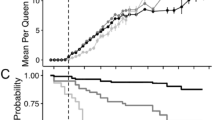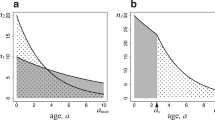Abstract
THE success of organisms and their increasing complexity throughout the course of evolution are thought to have depended on a small number of important transitions, one of which was the shift from a solitary lifestyle to societies of organisms exhibiting division of labour and having specialized castes1,2. The most familiar examples of the advantages arising from division of labour and caste differentiation come from social insects3. It has been suggested that the proportion of workers of various physical castes has evolved to enhance the fitness of colony members4,6 with the prediction that caste ratios should vary with environmental factors such as predation, competition and food availability. However, because it has been difficult to manipulate experimentally the environmental factors believed to influence optimal caste ratio, demonstration of adaptive caste distribution has remained elusive7–10. Here we show that colonies of the ant Pheidole pallidula increase the relative investment in soldier production after perceiving the presence of foreign con-specific colonies. This is the first experimental demonstration of a social insect altering physical caste ratios in an adaptive manner.
This is a preview of subscription content, access via your institution
Access options
Subscribe to this journal
Receive 51 print issues and online access
$199.00 per year
only $3.90 per issue
Buy this article
- Purchase on Springer Link
- Instant access to full article PDF
Prices may be subject to local taxes which are calculated during checkout
Similar content being viewed by others
References
Smith, A. The Wealth of Nations (Penguin, London, 1776).
Szathmary, E. & Maynard Smith, J. Nature 374, 227–231 (1995).
Wilson, E. O. Science 190, 798–800 (1975).
Oster, G. & Wilson, E. O. Caste Ecology in the Social Insects (Princeton Univ. Press, 1978).
Wilson, E. O. Behav. Ecol. Sociobiol. 16, 89–98 (1984).
Wilson, E. O. Science 228, 1489–1495 (1985).
Johnston, A. B. & Wilson, E. O. Ann. ent. Soc. Am. 78, 8–11 (1985).
Calabi, P. & Traniello, J. F. A. Behav. Ecol. Sociobiol. 24, 69–78 (1989).
Hasegawa, E. Behav. Ecol. Sociobiol. 33, 73–77 (1993).
Beshers, S. N. & Traniello, J. F. A. Ecology 75, 763–775 (1994).
Passera, L. & Suzzoni, J. P. in Morphogenetic Hormones of Arthrods (ed. Gupta, A. P.) 400–430 (Rutgers Univ. Press, New Brunswick, 1991).
Detrain, C. & Pasteels, J. M. Behav. Ecol. Sociobiol. 29, 405–412 (1992).
Hölldobler, B. & Lumsden, C. J. Science 210, 732–739 (1980).
Gordon, D. M., Behav. Ecol. Sociobiol. 31, 417–427 (1992).
Nonacs, P. & Calabi, P. Proc. R. Soc. Lond. B 249, 95–99 (1992).
Zar, H. J. Biostatistical Analysis (Prentice-Hall, Englewood Cliffs, 1984).
Aron S., Passera, L. & Keller, L. J. evol. Biol. 7, 403–418 (1994).
Wheeler, D. E. Am. Nat. 138, 1218–1238 (1991).
Wheeler, D. E. & Nijhout, H. F. Science 213, 361–363 (1981).
Hölldobler, B. & Wilson, E. O. The Ants (Springer, Berlin, 1990).
West-Eberhard, M. J. A. Rev. Ecol. Syst. 20, 249–278 (1989).
Keller, L. & Ross, K. G. Science 260, 1107–1110 (1993).
Keller, L. & Ross, K. G. Behav. Ecol. Sociobiol. 33, 121–129 (1993).
Pfennig, D. W. & Collins, J. P. Nature 362, 836–838 (1993).
Stearns, S. C. The Evolution of Life Histories (Oxford Univ. Press, 1992).
Ratnieks, F. L. W. & Reeve, H. J. theor. Biol. 158, 33–65 (1992).
Passera, L. Insectes soc. 25, 117–126 (1978).
Hamilton, W. D. J. theor. Biol. 7, 1–52 (1964).
Maynard Smith, J. in Evolutionary Progress (ed. Nitecki, M. H.) 219–223 (Univ. Press of Chicago, 1988).
Author information
Authors and Affiliations
Rights and permissions
About this article
Cite this article
Passera, L., Roncin, E., Kaufmann, B. et al. Increased soldier production in ant colonies exposed to intraspecific competition. Nature 379, 630–631 (1996). https://doi.org/10.1038/379630a0
Received:
Accepted:
Issue Date:
DOI: https://doi.org/10.1038/379630a0
This article is cited by
-
Social Parasite Exposure and Nest Hygiene in Acorn Ants
Journal of Insect Behavior (2023)
-
Among the shapeshifters: parasite-induced morphologies in ants (Hymenoptera, Formicidae) and their relevance within the EcoEvoDevo framework
EvoDevo (2021)
-
Density dependence and the spread of invasive big-headed ants (Pheidole megacephala) in an East African savanna
Oecologia (2021)
-
Ant colonies: building complex organizations with minuscule brains and no leaders
Journal of Organization Design (2021)
-
Evolution, phylogenetic distribution and functional ecology of division of labour in trematodes
Parasites & Vectors (2019)
Comments
By submitting a comment you agree to abide by our Terms and Community Guidelines. If you find something abusive or that does not comply with our terms or guidelines please flag it as inappropriate.



